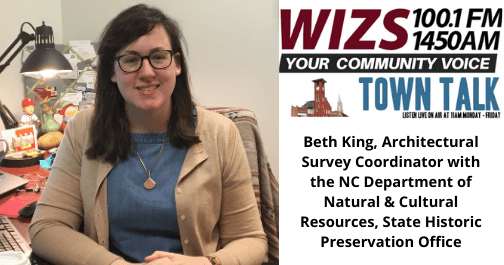Local history buffs, take note: Vance County is one of six counties chosen to have a comprehensive architectural survey conducted over the next couple of years. A state historic preservation expert was on Town Talk Thursday to discuss the project with Bill Harris and Mark Pace.
Elizabeth King, architectural survey coordinator with the NC Department of Cultural Resources, said the next step – after selecting field workers – will be to have a “scoping phase” which could start as early as this summer. This phase should take about six months and includes examining the 300-plus properties already identified in Vance County, most of which are in Henderson. The second phase involves conducting a complete evaluation of rural Vance County, including Kittrell and Middleburg, she said. Then the final phase, which should start in early 2023, will take a thorough look at yet-to-be-identified properties in Henderson.
King said this project is “long, long overdue” for Vance County. The project is scheduled to be completed by late 2023.
The most recent architectural survey was conducted in 1974 and was meant to be merely an information-gathering project rather than a comprehensive record of buildings and places with historical significance, she said.
Back in 1966, Congress passed the National Historic Preservation Act, whose mission was to create a national inventory of historic buildings and historic places, King noted.
As coordinator of the survey in her role with the State Historic Preservation Office, she said she is “standing on the shoulders of giants” because North Carolina is recognized for having one of the best architectural survey programs in the nation.
Click play for 3-18-21 TownTalk broadcast.
In the early 1970’s, young people, many fresh out of college, were hired to do a county-by-county inventory of historic buildings, King said. They interviewed residents in the communities and created a record of historic places that were beginning to disappear from the landscape and from people’s memories. “These young surveyors were going out and capturing local history from some of the last people who were living that agrarian lifestyle,” she said of the work done back then.
The migration from rural to city life after World War II, as well as the creation of Kerr Lake in the 1950’s are a couple of factors that contribute to fading memories and disappearing buildings that could be considered architecturally and historically significant.
King said she and her colleagues in the historical preservation field use “the 50-year rule” when talking about historical significance of buildings and places. This year, a building built in 1971 could be considered as having historical significance, she explained. “But it may not be ‘historic’ with a Capital H,” she said. “We have to continually be moving that needle to be capturing younger aspects of our history,” King added.
What makes or breaks projects such as the survey is local involvement, King said. “We want to raise awareness at a local level of what is special and regionally unique” to the area, she said. A public meeting will be held closer to the beginning of the field work phase to exchange information with the community. King said the project will certainly have a technical component to collect information such as window patterns, roof lines and the like, but another component is “to listen and absorb” information from the community.
And rest assured, she said, that nobody associated with the survey will visit a property without permission. “We do not trespass. If we aren’t invited on someone’s property, we will attempt to make contact,” she said, adding that all workers would be clearly identified and will carry business cards and official letters stating the purpose of their visit.
To learn more, contact King at elizabeth.king@ncdcr.gov or 919.814.6580.

















